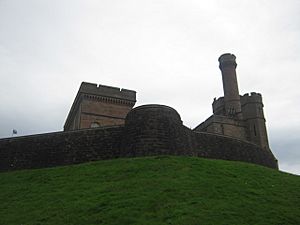Siege of Inverness (1715) facts for kids
Quick facts for kids Siege of Inverness (1715) |
|||||||
|---|---|---|---|---|---|---|---|
| Part of Jacobite rising of 1715 | |||||||
 Inverness Castle in modern times. Some of the old curtain wall can be seen in the foreground, while the castle building itself was rebuilt in 1836 |
|||||||
|
|||||||
| Belligerents | |||||||
| Clans loyal to British Government: Clan Fraser of Lovat Clan Rose Clan Forbes Clan Munro Clan Grant |
Jacobite clans: Clan Mackenzie Clan MacDonald of Keppoch |
||||||
| Commanders and leaders | |||||||
| Simon Fraser, 11th Lord Lovat Sir Robert Munro, 6th Baronet |
Sir John Mackenzie of Coul | ||||||
| Strength | |||||||
| Frasers: 800 Forbes: 200 Roses: 300 Munros: 400 Grants: 800 |
Mackenzies: 300 MacDonalds of Keppoch: 300 |
||||||
| Casualties and losses | |||||||
| 1 killed | None | ||||||
The siege of Inverness happened in November 1715. It was a part of the Jacobite rising of 1715. During this time, people who supported the Jacobites were trying to put a new king on the throne. The town of Inverness and Inverness Castle were controlled by the Clan Mackenzie. Their leader was Sir John Mackenzie of Coul. He supported the Jacobite rebels.
Simon Fraser, 11th Lord Lovat was the chief of the Clan Fraser of Lovat. He led a group of clans who attacked the town. These groups included men from the Clan Rose and Clan Forbes.
Why the Siege Happened
Simon Fraser, 11th Lord Lovat, had been living away from Scotland. He was worried that his family's lands would be taken over by a Mackenzie. This Mackenzie was married to a relative of Simon's.
When the Jacobite rising of 1715 began, Lord Lovat came back to Scotland. Even though he had supported the Jacobites before, he offered to help the British government. He wanted to get his lands back. The leader of the British forces in Scotland, John Campbell, 2nd Duke of Argyll, decided to give him a chance. This was a big surprise for the Jacobites.
Lord Lovat then met with John Forbes of Culloden. Forbes also supported the government. They joined up with Hugh Rose, the chief of the Clan Rose, at Kilravock Castle. Rose was a strong supporter of the government.
The Attack on Inverness
Lord Lovat, Forbes, and Rose gathered their forces. They stood on the side of the River Ness, across from Inverness Castle. The town council of Inverness supported the Jacobites. They sent a message asking for help from the chief of the Clan MacDonald of Keppoch.
The MacDonalds tried to approach the Frasers from behind. But Lord Lovat sent a messenger, Reverend Thomas Fraser, to talk with them. The MacDonald chief decided not to fight his way into Inverness. He went south through the hills instead.
Sir John Mackenzie of Coul, who was in Inverness, also asked for help. He sent a message to the Clan Mackintosh chief. He asked for 500 men to help the 300 Mackenzies already in Inverness. In response, Lord Lovat ordered his troops to move south of Inverness. He threatened to attack the Mackintosh lands. The Mackintoshes then backed down. They said they only moved to defend their lands and did not want to join the rebellion.
Lord Lovat held a meeting with his men. Some leaders wanted to surround the town and starve out the Jacobites. But Lord Lovat decided to attack the town directly.
Before the main attack, a young man named Arthur Rose, with his brother Robert and a few others, went towards Inverness in a boat. Rose of Kilravock and Forbes of Culloden had already blocked the town from the southeast.
Sir John Mackenzie learned about the coming attack. He took a strong position in the Tolbooth. This was a strong building in the center of town that served as a guard house. Arthur Rose surprised a guard with his pistol in the dark. He used the guard to open the door of the guard house. Rose tried to rush in, but the guard shouted that he was an enemy. Arthur Rose was caught in the door and shot dead by the Mackenzies. He was the only person who died in the siege.
The next day, Sir John Mackenzie of Coul agreed to give up Inverness. He asked to be allowed to join the Earl of Mar. Mar was the leader of the Jacobite army. Sir John Mackenzie and his men quickly left Inverness by boat. They left all their belongings behind to avoid meeting the approaching Frasers.
What Happened Next
On November 12, 1715, the government forces took control of Inverness. Simon Fraser, 11th Lord Lovat, marched into the town. He was joined by 800 men from Clan Grant and 400 men from Clan Munro.
Lord Lovat left Inverness on November 15, 1715. Sir Robert Munro, 6th Baronet was made the new Governor of the town. For some time, the rebels were disarmed. A group of Munro men, led by Sir Robert's younger brother, George Munro, 1st of Culcairn, helped with this.
On March 10, 1716, George I of Great Britain signed a paper. This paper officially made Simon Fraser, 11th Lord Lovat, a free British subject. This was the first time in twenty years he had this status.

